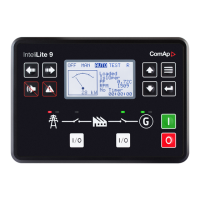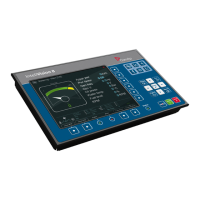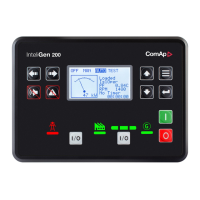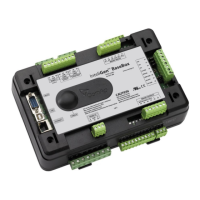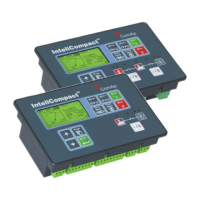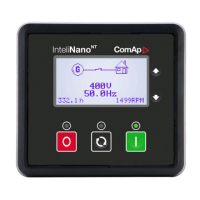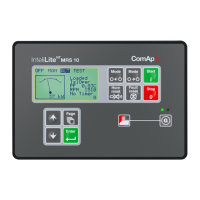InteliMains 210 Global Guide
88
The Running hours equalization function compares RHE value of each controller in the group. Once the
difference between RHE of individual controllers is higher than #Run Hours Max Difference (page 200) (i.e. #Run
Hours Max Difference (page 200) + 1), the gen-set(s) with the lowest RHE is/are started.
Example: The system structure and its settings is shown on the figure below.
Image 5.22 Example of the system
3 cases are considered:
Case #1: 2 gen-gets available
Case #2: 3 gen-gets available with same initial RHE.
Case #3: 3 gen-gets available with different initial RHE.
Case #1:
Gen-set 1 running hours = 250 -> running hours considered in RHE = 100 (150 - Run Hours Base (page 200))
Gen-set 2 running hours = 450 -> running hours considered in RHE = 200 (250 - Run Hours Base (page 200))
Both gen-sets have the same nominal power of 700 kW. Originally, priority of gen-sets was G1 = 2, G2 = 1.
Load demand in this example is constant and it is 500 kW (i.e. only one engine is running at any time). In this
case, the controllers set the engine priority of the gen-set 1 to 1 because it has the lowest considered RHE and
the difference between RHE2 (i.e. considered RHE of gen-set 2) and RHE1 is higher than #Run Hours Max
Difference (page 200) that is set to 10h.
Run hours #RunHoursBase RHE
Gen-set #1 250 150 100
Gen-set #2 450 250 200
The gen-set 1 runs for 100 hours to equalize the RHE of both gen-sets. The gen-set 1 keeps running until the
difference between RHE1 and RHE2 exceeds #Run Hours Max Difference (page 200) (i.e. 10h). The gen-set 1
runs 100 + #Run Hours Max Difference (page 200) + 1 = 100 + 10 + 1 = 111 hours. After 111 hours the gen-sets 2
has the lowest RHE and the difference between RHE1 and RHE2 is higher than #Run Hours Max Difference
(page 200). The gen-set 2 runs 11 hours to equalize the RHE of both gen-sets and then additional #Run Hours
Max Difference (page 200) + 1 hours (i.e. 11 + 10 + 1 = 22 hours). The evolution of RHE1 and RHE2 is shown on
the figure below.
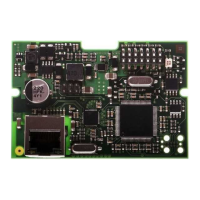
